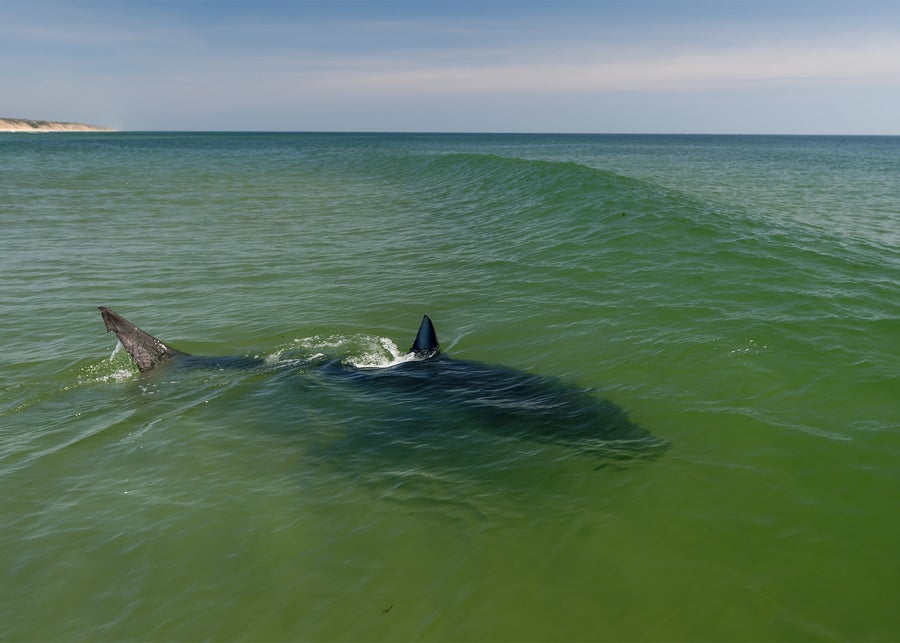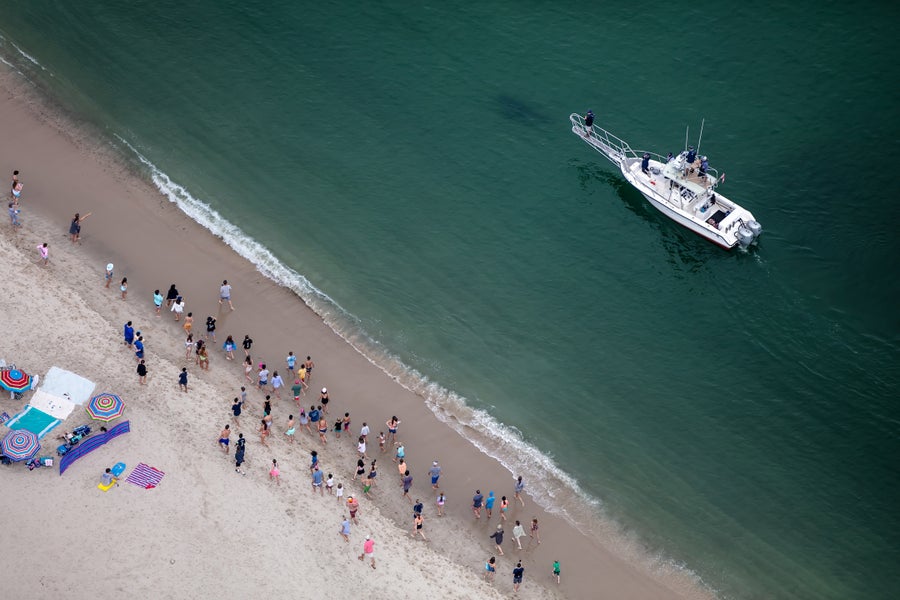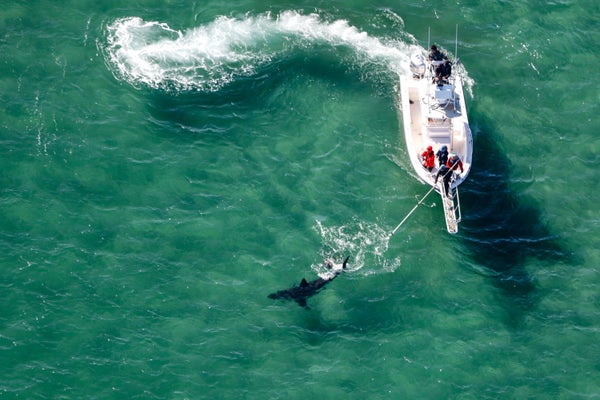They’re here. Once rare in this area, great white sharks—hundreds of them—are hunting in the shallow waters along the beaches of Cape Cod in Massachusetts. The upsurge over the past decade has caught just about everyone by surprise, including marine scientists. Renowned shark expert Greg Skomal, who has studied white sharks off the coast of New England since the early 1980s, says he didn’t encounter one anywhere near Cape Cod until 2004 and didn’t tag his first one there until 2009.
A new study shows that this peninsula’s eastern shoreline now hosts one of the largest seasonal white shark gatherings in the world and is the first such hotspot documented in the North Atlantic. Cape Cod joins established hotspots in South Africa, central California, Mexico’s Guadalupe Island and Australia’s Neptune Islands. The sharks are most concentrated by Massachusetts during June through October—the same time of year when more than three million vacationers regularly flock to the cape.
The public safety implications are obvious. The sharks hunt in the swells along some 40 miles of beachfront managed by the Cape Cod National Seashore. Leslie Reynolds, deputy superintendent for the organization, says 2012 was the first time a shark injured a person along this beachfront area. Two incidents followed, including a fatal encounter in 2018. Although there have been no attacks since then, the danger is ever present. A working group convened by Reynolds that included municipal beach safety directors, along with representatives of the Massachusetts Department of Marine Fisheries and The Atlantic White Shark Conservancy, has implemented safety measures such as new beach signs, a flag warning system, training on how to stop a victim’s bleeding, and public outreach and education about shark threats. An iPhone app called Sharktivity gives the latest sightings.
The shark conservancy brought in white shark experts from other parts of the world to advise the safety planners. “Understanding shark population trends, movement and behavior is crucial for shark safety and conservation,” says Alison Kock, a marine biologist for the South African National Parks, who visited Cape Cod in 2016.

A 15-foot female white shark hunts at the edge of a surf break along Cape Cod’s popular Coast Guard Beach in Eastham, Mass. Credit: Pamela King
Sharks are convening on the cape because the gray seal population there is rebounding, experts say. The seals had been extirpated from New England by the early 1960s, largely a result of culling by commercial fishers. The Marine Mammal Protection Act of 1972 made it safe for the seals to return from Canadian waters, but they didn’t establish pupping colonies until the early 1990s. With no natural predators and plenty of fish to eat, the seals thrived. By one estimate, more than 30,000 seals were on the cape by 2017. The sharks were likely drawn to them by scent trails. Seals are a favorite fat-rich prey for white sharks as the fish make their annual northern migration.
White sharks are protected as well. The U.S. government designated them as a “prohibited species” in 1997, making it illegal to catch the sharks between three and 200 nautical miles out to sea. Massachusetts followed suit in 2005, prohibiting capture between shore and three miles out.
Many environmentalists view what’s happening on Cape Cod as a conservation success story. Public safety concerns about both seals and sharks could have led to draconian measures, such as culling, but instead nature was left to take its course. “What we’re seeing at Cape Cod is a reestablishment of the trophic (food) web and what it may have been like before overfishing and the slaughter of many of the animals at the top of the food chain,” says Chris Lowe, director of the Shark Lab at California State University, Long Beach.

A tagged shark called Mr. Spot Claw is followed by Atlantic White Shark Conservancy researchers on the Aleutian Dream as dozens of beachgoers watch from Cape Cod’s Nauset Beach in Orleans, Mass. Credit: Wayne Davis
As white shark sightings rose in the early 2010s, people ranging from National Park officials to conservation organization leaders to cape residents wanted to know how big the population was getting. That prompted a four-year study that included Skomal, a senior fisheries biologist at Massachusetts’s Division of Marine Fisheries. The researchers estimate that about 800 individual white sharks visited the sampling area from 2015 to 2018.
Over the past decade population studies have been conducted at white shark hotspots along California’s central coast, in South Africa and at Guadalupe Island; the estimated populations were 300, 908 and 78, respectively. Like those studies, the Cape Cod project identified sharks by their unique coloration and dorsal fin profiles. But the other studies all used baits or artificial attractants to lure sharks to a research vessel for observation. Sharks that are willing to approach a boat are likely a subset of all sharks in the area, and this introduces uncertainty in the data.
“No decoys or baits were used to attract sharks” in the Cape Cod study, says Megan Winton, lead researcher and a staff scientist at the Atlantic White Shark Conservancy, the nonprofit organization that provided most of the research funding. “Instead we relied on a spotter plane to find free-swimming sharks and radioed their locations to a research vessel,” the Aleutian Dream. “Once we located a shark, we shot underwater videos with a GoPro camera attached to a fiberglass painter’s pole.” The sheer volume of data compiled also distinguishes the study: the researchers conducted 137 survey trips, encountered sharks 2,295 times and collected a total of 2,803 videos.
But does the Cape Cod shark population represent an increase in the overall North Atlantic population? It’s hard to know. Those sharks were somewhere else before they started visiting the cape. “Just because we’re seeing them or we’re not seeing them doesn’t mean that their numbers have changed,” says Taylor Chapple, an assistant professor at Oregon State University’s marine, fishing and wildlife department, who was involved with the central California studies. “It may just mean that their behavior or distribution has changed or our ability to find them has changed.”
Skomal agrees but adds, “Our population estimates increased with each year of our study. This general trend is indicative of growing population, at the very least at Cape Cod and possibly beyond.”
The study has stimulated other questions. Is the shark population off Cape Cod still growing? What impact would this have on the seal population? What is the size of the broader Northwest Atlantic white shark population?
To pursue answers, the Cape Cod research team is studying predator-prey relationships, the fine-scale movement of sharks near the shore and other phenomena that will provide greater insight into the biology, ecology and natural history of the species. As John King, captain of the Aleutian Dream, puts it, “The population study is just the end of the beginning.”
